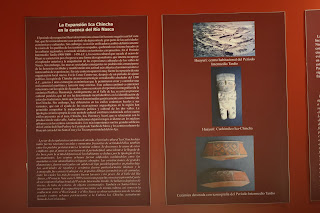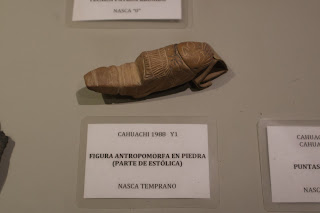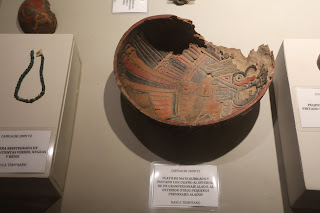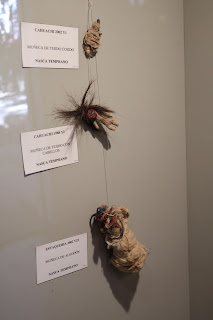The Antonini Archaeological Museum is located in the Peruvian city of Nazca.
The museum preserves and studies the archaeological heritage of the Nazca
area, coming from the archaeological research work that has been carried out
by the "Nazca Project" in the ceremonial center of Cahuachi and other
important sites in the Nazca River Valley since 1982.
|
Entering the Antonini Museum
|
Room 2
|
The ceremonial center of Cahuachi
24 km west of the city of Nazca is Cahuachi, the largest adobe
ceremonial center in the world. The entire set of structures was built
on a desert alluvial terrace, on the left bank of the Nazca River, in
the middle valley of the same river.
-
From the 4th century BC. Until the 5th century AD, it has been the
most important theocratic center of the Nazca Culture, exercising its
ideological force through religion, which was the greatest element of
cohesion of the social groups under its domination.
-
Cahuachi, after its decline, was reused as a necropolis by the
inhabitants of the valley.
-
It is made up of two different nuclei, surrounded by walls,
characterized by very large groups of buildings in the shape of
pyramidal mounds. These are structures with a square or rectangular
plan, made up of ascending platforms, which gives them the appearance
of a truncated pyramid.
-
The two centers functioned simultaneously and in their spaces a great
variety of ceremonial temples were concentrated, hosting during
certain periods of the year, thousands of people who came from the
most remote regions of the territory interested in the Nazca religion.
-
Inside there are no residential areas of the town nor were any
activities carried out that were not directly related to their own
religious world.
-
In an area of 24 km squares on both slopes of the valley were built
temples, ceremonial enclosures, buildings with enormous structures,
surrounded by columns and complemented by large roofs that covered the
platforms.
|
|
Photos of the Cahuachi Ceremonial Center
- Top: General view of Zone A of Cahuachi.
- Middle: Interior of the Great Pyramid and its access staircase.
- Bottom: General view of the South Temple and the Great Pyramid.
|
|
Pot with embossed arms and hands
|
|
Bowl fragment
Nazca 3.
-
With character decoration with crozier and hackamore, and feline with
scolopendra body.
|
|
Sculptural male figurine
Early Inca.
- With necklace, blanket and hat decoration.
|
|
Globular bottle
Nazca 6.
- With feline character with diadem and nose ring.
|
Room 3
|
The Ica-Chincha Expansion in the Nazca River basin
The period of Huari occupation determined a rather negative situation on
the South Coast, which initially led to a period of depression in much
of the economic and cultural activities. However, its unifying action
definitively changed the vision of the people of the occupied
territories, breaking a system based on regional cultures, often
isolated in circumscribed territories.
-
In the Late Intermediate Period (900/1000 - 1450 CE), the cultural
scene that follows the decline of Huari is characterized by the return
to a form of regionalism, which attempts to recover the splendor prior
to the annihilation of the cultural expressions of the valleys from
Nazca. However, the new emerging societies will no longer be able to
emancipate themselves from the inheritances received and will manifest
a more open attitude to innovations and exchange of experiences. In
this context the expression of a new local organization appeared very
strong.
-
On the South-Central Coast, after a period of political adjustment,
the Chincha region achieved considerable prestige around 1300 CE,
thanks to economic strategies that allowed it to create and control a
very extensive maritime and land commercial network. This culture
continued to entertain relations with the Ayacucho region, as noted in
the iconographic repertoire of Pinilla and Huamanga ceramics.
-
Similarly, in the Ica Valley, a parallel cultural process took place,
which perhaps has determined uncertainties in the identification of
these two traditions, so much so that they were generically called by
the name of Ica-Chincha. However, there are differences in the local
ceramic styles and their variants, which with the help of
archaeological excavations in the region have made it possible to
verify the political and cultural independence of the two valleys.
-
The ceramic typology of this cultural period is well evidenced in the
four styles present in the area, Chincha, Ica, Poroma and Acari, which
are related to the production of each valley.
-
Both traditions left evident features in the urban centers and
ceremonial centers. The most important are the large buildings of the
Centinela di San Pedro and the Centinela de Tambo de Mora, and the
urban centers of Huayuri near the Santa Cruz River and La Tiza near
the Aja River.
|
|
Offering heads
Early Nazca.
- With incisions in the occipital part.
|
|
Canister fragment
Nazca 3.
- With drawings of offering heads.
|
|
Offering heads
Early Nazca.
- With incisions in the occipital part.
|
|
Offering heads
Early Nazca.
|
|
Child's funeral bundle
Middle Horizon.
|
|
Anthropomorphic idol
Nazca 3.
- Tomb offering, made in limestone.
|
|
Dishes
Middle Horizon.
- With serpentine, half-moon, zig-zag and staggered decoration.
|
|
Partially reintegrated cup
Nazca 3.
- With stylized lizard designs.
|
|
Partially reintegrated cup
Nazca 3.
- With character design, with diadem and nose ring.
|
Room 4
|
Sculptural ceramic bottle
Early Nazca.
- In the shape of a bird, with neck and bridge handle.
|
|
Anthropomorphic figure
Early Nazca.
- Part of stolic, in stone.
|
|
Sculptural ceramic bottle
Early Nazca.
- In the shape of a monkey, with an incised face.
|
|
Modeled clay figurines
Early Nazca.
- Wrapped with textile fragment. Possibly dolls.
|
|
Reintegrated fragment of anthropomorphic vessel
Nazca 3.
- Character with diadem, nose and ears in high relief.
|
|
Matte chiselled and painted
Early Nazca.
- Character design with diadem, nose ring, and crosiers.
|
|
Matte chiselled and painted
Early Nazca.
- Inside: painted with a design of a large winged character.
- Outside: features other designs of small winged characters.
|
|
Small twin bowls in painted and chiselled matte
Early Nazca.
- With drawings of felines with diadems.
|
|
Small chiseled and painted matte
Early Nazca.
- Painted with the representation of a crab.
|
|
Reintegrated matte bowl
Nazca 1.
-
Pyro-recorded inside and outside with representations of the Nazca
religious world.
|
|
Dolls
Early Nazca.
- Top: Doll in sewn fabric.
- Middle: Fabric doll with hair.
- Bottom: Cotton doll.
|
|
The painted mattes
In 2008, the discovery of a large offering in the Orange Pyramid was
recorded, with 88 ceramics and other associated objects, among which a
large number of mates painted with resinous colors.
-
In the iconography of some of them, feline figures with the body and
wings of birds are observed, very rarely found with these
characteristics. This is a unique case, so far, of a discovery with
these peculiarities.
-
In this case, the technique typical of Paracas ceramics was used, with
the use of resinous paints applied after firing. In the case of the 13
mattes found with this characteristic, the resinous colors have been
applied to the surface of the mattes, after having incised some parts
of them.
-
Among the most significant are those that reproduce feline figures. In
this case, the resinous paint related to the coloring of the nose
rings and diadems has been used, incorporating gold and silver powder,
for greater preciousness of the representations.
|
Room 6
|
Small bottle with two spouts and bridge handle
Early Nazca.
- With design of bicephalous scolopendra with feline heads.
|
|
Sculptural female figurine
Late Nazca.
|
|
Ceramic bottle with two spouts and bridge handle
Early Nazca.
- With anthropomorphic designs.
|
|
Cup reintegrated
Early Nazca.
- With drawings of inverted offering heads.
|
|
Cup reintegrated
Early Nazca.
- With a drawing of a serpentine being.
|
|
Pitcher
Middle horizon.
- With drawings of zoomorphic heads (felines).
|
|
Funeral bundle with false head
Late Nazca.
- Made with textile fragments, sling and cotton fiber.
|
|
Bowl
Early Nazca.
- With representation of offering heads.
|
|
Tomb reconstruction
Early Nazca.
|
|
Dishes
Early Nazca.
-
Top: Plate with drawings of double-headed snakes that overlap each
other.
-
Bottom: Small plate with a drawing of an animal head and parallel
lines.
|
|
Incomplete cup
Late Nazca.
|
|
Cradle
Late intermediate.
- Made with wild cane and wood branches, tied with ropes.
|
|
Anthropomorphic idol
Middle horizon.
|
|
Sculptural cup
Nazca 6.
- With anthropomorphic face.
|
|
Small anthropomorphic sculptural bottle
Nazca 6.
|
|
Elongated vase
Nazca 6-7.
- With an anthropomorphic face, with staggered hair.
|
|
Reintegrated sculptural vessel
Nazca 3.
- With character holding on chillies.
|
|
Pitcher with a flattened spherical body
Early intermediate period.
- With drawings of stylized feline heads and symbols.
|
Room 7
|
The model of a Paracas-Nazca temple
The models present in the Antonini Museum are a unique example of the
architectural expression of the Nazca Culture. They have been found more
than thirty years ago in the Majuelos Valley: one represents a stepped
temple, with the upper part accessible. Three-dimensional human figures
and the image of divinity were positioned inside.
-
The main façade has a rectangular opening for access to the interior,
with a lintel decorated with quadrangular incisions. The main façade
shows the presence of two effigies of characters, in a position to
move in the same direction. The two figures wear conical-shaped caps,
are represented in bas-relief and decorated with incised dots. On the
façade there are two open windows, which outline the appearance of
fish.
-
At the entrance to the building there are two figures in a bulk, in an
erect position, naked, resting with their backs against the entrance
frame and with their arms resting on their bellies: the hands and feet
show only three fingers. There is no evidence of sex, but possibly two
women, due to the absence of the penis protuberance.
-
Inside the building there are two other characters made in bulk. On
the internal wall, opposite the façade, you can see the figure of a
character larger than those already described and with his feet in a
position separated from the floor, as if he were a bulk sculpture. The
head is adorned by a large relief headdress with evidence of three
upper limbs in the shape of triangles, possibly representing rays and
located above a prominent semicircular shape.
-
The rear façade has no openings, but there is decoration of two
different figures of feline divinity. The two horizontal images are
those of the flying feline, with the representation of large earflaps
with circles, a headband, and a cetacean tail.
-
The upper surface originally had two walls corresponding to the
facades of the building with decorations in relief, as can be seen by
looking at the remains of a hand or foot in relief and incised, which
still appears at the base of the roof of the rear facade.
-
The model is one of the few in existence with complete evidence of a
Late Paracas or Early Nazca temple in its three-dimensional
representation and with bulk characters.
-
The ceramics are not limited to the representation of a temple, but
also of a ritual that took place inside, with four characters
participating in the ceremony, in front of the image of a divinity.
|
Museum garden
|
Museum garden
The museum has an aqueduct running through the back garden.
|
See also
Source
Location




























































